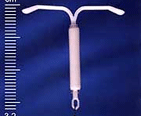 Mirena is levonorgestrel-releasing intrauterine system. It is a hormonal birth control method for women. Mirena IUD, like other IUDs, is a T-shaped device. The difference is that it contains of 52 mg levonorgestrel (progestogen hormone), which is constantly released directly into the uterus at the amount of 20 µg/day. Its contraceptive effect lasts for up to five years. This IUD should be removed not later than 5 years after insertion.
Mirena is levonorgestrel-releasing intrauterine system. It is a hormonal birth control method for women. Mirena IUD, like other IUDs, is a T-shaped device. The difference is that it contains of 52 mg levonorgestrel (progestogen hormone), which is constantly released directly into the uterus at the amount of 20 µg/day. Its contraceptive effect lasts for up to five years. This IUD should be removed not later than 5 years after insertion.
Mirena IUD
Levonorgestrel is a chemical form of a progestogen hormone, which in natural form is one of the most essential female sexual hormones. In vivo it is provided by the ovaries. Birth control pills – both combined and progestogen only – also consist of levonorgestrel.
Levonorgestrel is responsible for contraceptive effect of Mirena IUD. It has three mechanisms of action, which enables Mirena IUD to be highly effective in birth control . Levonorgestrel thins the uterine lining, thickens the cervical mucus and inhibits sperm mobility.
It does not have any effects on the ovaries but some users may experience absence of ovulation.
The efficiency of Mirena IUD
Mirena IUD is highly effective in birth control. Its effectiveness is up to 99.9 %, a failure rate being 0.16 per 100 women per years of use. It is nearly as effective as tubal ligation or vasectomy. Contraceptive effect is reversible, and 80 percent have been able to become pregnant within 12 months after removal of the intrauterine device .
To be able to use Mirena IUD, a woman must have had at least one previous pregnancy. No history of previous pelvic inflammatory disease (PID) is one of the main requirements for eligibility for this type of intrauterine device. Mirena does not protect against sexually transmitted diseases (STDs).
Contraindications of using Mirena IUD
Pregnancy, cervical dysplasia, genital infections, uterine or cervical cancer, undiagnosed abnormal bleeding are the main contraindications for the use of this IUD. In addition, women who have or have had breast cancer should not use it either. Women, who have a history of icterus, headaches and migraine, hypertension, leukemia, heart disorders, should consult their doctor about other options of birth control .
How to insert Mirena IUD
Mirena IUD should be inserted into the uterus at the doctor‘s office seven days of the onset of period or straight after first trimester abortion. A doctor should check for infection before inserting the device. The cervix should be inspected to determine the size of a uterine device.
Follow ups are recommended after insertion of Mirena IUD . First examination should be scheduled in two weeks. Regular check ups should be performed every three months to consult about bleeding, weight gain, lower abdomen pain, headache and other side effects. Mirena IUD is to be taken out after five years of use. It is best to remove the device during period, since removal of Mirena at other times of the cycle may require the use of additional birth control methods .
Mirena IUD side effects
Even though Mirena IUD is an effective and easy to use method of contraception, just like all hormonal birth control options, it has possible side effects. Since the active ingredient levonorgestrel affects the uterine lining, one of the most common side effects is irregular bleeding and spotting during the first 3 – 6 months. The number of such days continuously diminishes and even 20 % of Mirena users have no bleeding at all by the end of the first year of use. Therefore, a woman should consult a doctor about possible changes in the menstrual pattern to be ready for such effects.
Other possible side effects include lower abdominal pain, nausea, weight gain, headaches, back pain, irritability and others. But these are quite uncommon side effects, and the advantage of this device higher. There is also a low risk of ectopic pregnancy, and therefore, it is recommended to not insert Mirena IUD to women who have a history of ectopic pregnancy. The risk of infection is slightly higher, compared to women, who do not use this device, and therefore additional measures should be taken to protect against STD‘s.
The cost of Mirena IUD is about $300. If you are not satisfied with current method of contraception and considering about Mirena IUD, consult your doctor about the advantages and disadvantages of this device. And if you are a good candidate for this device and decide to use it, you might be actually happy to keep your life simple.